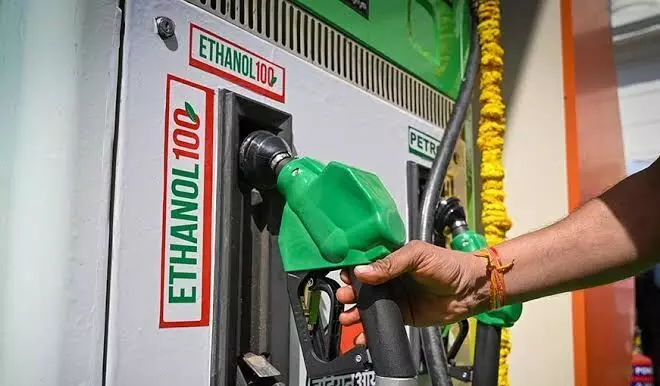Explained: All you need to know about E20 fuel and the buzz around it
Many sections of vehicle owners are resisting the government E20 plan, expressing concern about its impact on vehicles
By Kedar Nadella
Explained: All you need to know about E20 fuel and the buzz around it
Hyderabad: Ethanol-blended fuel has become the buzzword across the country with the Central government announcing the implementation of 20 per cent ethanol blending in petrol.
Many sections of vehicle owners are resisting the government E20 plan, expressing concern about its impact on vehicles’ health and performance, and the impact on fuel prices.
Most of the social media chatter is about the pricing, with many claiming that ethanol-blended fuel will be costlier. However, Financial Express reported that, as per a NITI Aayog report from 2021, ethanol blending will lower petrol prices.
The report stated that India can save up to Rs 30,000 crore per annum and offer ‘equivalent efficiency at lower cost than petrol.’
What is the Ethanol Blended Petrol (EBP) Programme?
India’s EBP programme started in 2003 with the sale of 5 per cent ethanol-blended petrol in 9 States and 4 Union Territories. This was extended to 20 States and 4 union territories in 2006
According to the PIB release from January 25, the Central Government has been implementing the Ethanol Blended Petrol (EBP) Programme wherein OMCs sell petrol blended with ethanol up to 20 per cent. The programme is being implemented across the country to promote the use of alternative and environmentally friendly fuels.
This intervention also seeks to reduce import dependence for energy requirements and give a boost to the agriculture sector.
The programme aimed to achieve a target of 10 per cent blending by 2022, and by 2025, 20 per cent blending was achieved. The government has claimed that it has helped them save Rs 1.4 lakh in foreign exchange by cutting crude oil imports.
However, the major question is about its impact on vehicles.
What is ethanol fuel?
Fuel for vehicles comprising 20 per cent ethanol and 80 per cent petrol is referred to as E20 fuel. Ethanol is referred to as a biofuel that is sustainable and biobased, sourced from plant resources such as corn, sugarcane and other biomass.
In one litre of E20, there is 200 ml of ethanol and 800 ml of petrol. Ethanol (Formula - C2H5OH) is a biofuel which is naturally produced by the fermentation of sugars by yeasts or other organic matter.
Similar to E20, E5 and E10 blended fuels are made by mixing 5 per cent and 10 per cent ethanol with petrol. E5 has been in use in India since 2003.
Are all vehicles compatible with E20 fuel?
Recently, Union Minister of Road Transport and Highways threw an open challenge, asking anyone to show even a single vehicle that has been damaged due to ethanol-blended petrol.
However, as per an article by The New Indian Express, the Ministry of Petroleum and Natural Gas confirmed that ethanol has a lower energy density than petrol, which can cause a slight decrease in mileage.
“Four-wheelers designed for E10 and calibrated for E20 may experience a 1–2% drop in mileage, while other vehicles may see a reduction of 3–6%,” the report said.
In a survey conducted by LocalCircles, which received over 36,000 responses from petrol vehicle owners, 11 per cent of respondents (out of 22,282 responses received) said that the fuel efficiency/ mileage has reduced by over 20 per cent.
As many as 22 per cent of respondents stated it has reduced by 15-20 per cent, and 11 per cent of respondents stated it has reduced by 10-15 per cent.
“To sum up, 2 in 3 vehicle owners, with vehicles purchased in 2022 or earlier, say the vehicle’s fuel efficiency/mileage has reduced in 2025. This clearly indicates that there is an issue at hand, and it is leading to reduced fuel efficiency this year, as a result, having a financial impact on such vehicle owners,” said LocalCircles.
The report also stated that ethanol is hygroscopic (attracts water) and is more corrosive than petrol, as per an industry expert.
Do other countries use ethanol fuel?
Brazil currently uses 27 per cent ethanol-blended petrol (E27) along with 14 per cent blended with diesel. Brazil’s National Energy Policy Council (CNPE) on June 25 approved an increase in the levels of biofuel mixed into fossil fuels.
In the USA, 10 per cent ethanol blending in petrol (E10) is standard across most markets.
Thailand introduced a 10 per cent blend rate and wanted to increase this to 20 per cent in July this year. However, this was postponed to next year as ethanol prices soared to a five-year high on the back of higher feedstock prices and insufficient production of E20-compatible vehicles.
In the European Union, E5 blended fuel is widely used. Several countries have increased the blending and adopted E10 fuel. Most countries in Africa have also proposed or adopted blended fuel in the range of E5 to E10.